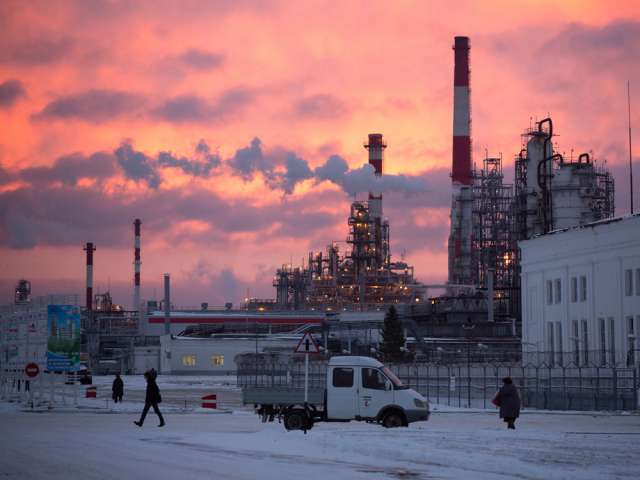
[ad_1]
LONDON — As OPEC watches a near 15 per cent drop in the oil price in three weeks, important indicators in the physical crude market are flashing signals that the decline might be far from over.
The warnings come not from the heavily traded futures market, but from less transparent trading activity in crude oil and products markets, where key U.S., European and Russian crude prices have fallen of late, suggesting less robust demand.
Benchmark oil futures have plunged in recent days together with global stock markets due to concerns over inflation as well as renewed fears that rapid output increases from the United States will flood the market with more crude this year.
OPEC, including its Secretary-General Mohammad Barkindo, argues the decline is just a blip because demand is exceeding supply and that prices won’t plunge again to US$30 per barrel as they did in 2015 and 2016.
Traditionally, when oil futures decline, prices in the physical markets tend to rise because crude is becoming cheaper and hence more attractive to refiners.
But in recent weeks, differentials in key European and U.S. markets such as North Sea Forties, Russia’s Urals, West Texas Intermediate in Midland, Texas, and the Atlantic diesel market have fallen to multi-month lows.
The reasons tend to be different for most physical grades but overall the trend paints a bearish picture.
“Physical markets do not lie. If regional areas of oversupply cannot find pockets of demand, prices will decline,” said Michael Tran of RBC Capital Markets.
“Atlantic Basin crudes are the barometer for the health of the global oil market since the region is the first to reflect looser fundamentals. Struggling North Sea physical crudes like Brent, Forties and Ekofisk suggest that barrels are having difficulty finding buyers,” he added.
Physical markets do not lie
Michael Tran, RBC Capital Markets
This follows a run-up in U.S. production to 10.04 million barrels per day as of November, the highest since 1970. The increase pushed the United States into second place among crude producers, ahead of Saudi Arabia and trailing only Russia, according to the U.S. Department of Energy.
On Tuesday, the Paris-based International Energy Agency said increased U.S. supply could cause output to exceed demand globally in 2018.
Forties crude differentials to dated Brent have fallen to minus 70 US cents, from a premium of 75 US cents at the start of the year as the Forties pipeline returned to normal operations.
Forties differentials are now not far off their lowest since mid-2017, when the benchmark Brent crude price was around US$45 per barrel, compared to US$62 now and US$71 a few weeks ago.
In the United States, key grades traded in Texas and Louisiana have fallen to their lowest in several months.
URALS, DIESEL STRUGGLE
A similar pattern can be observed in the Russian Urals market, one of the biggest by volume in Europe.
At a discount of US$2.15 to dated Brent, Urals’ differentials in the Mediterranean are now at their lowest since September 2016, when Brent futures were around US$40-$45 per barrel.
“Sour grades are not in good shape worldwide” and neither are Urals, said a European crude oil trader, who asked not to be identified as he is forbidden from speaking publicly.
That contrasts with the start of 2017, when OPEC cuts to predominantly sour grades made them attractive to buyers.
“Supply is more than ample in Europe, Urals face strong competition from the Middle Eastern grades,” said another trader on the Russian crude oil market, adding that supplies of Urals to Asia were uneconomic due to a wide Brent-Dubai spread.
Adding pressure on Urals, traders expect loadings of the grade to rise in the coming months due to seasonal maintenance at Russian refineries.

A decline in physical crude values generally means better margins for refiners. But it is also not happening this time.
The profit margin refiners make on processing crude into diesel collapsed in Europe and the United States by over 18 per cent in the past week, according to Reuters data.
Europe, where nearly 50 per cent of vehicles are fuelled by diesel, is home to the global benchmark for diesel prices and the biggest storage hub for the road fuel as regional refineries are unable to meet local demand.
“Oil demand isn’t that bad in general, but heating oil demand has been horrible, particularly in the United States and Germany,” Robert Campbell, head of global oil product markets at consultancy Energy Aspects, said.
“European refineries are running at very high rates since December so there is plenty of supply in the region while the weather has been warmer than usual, which led to weaker demand.”
The refined product markets were expected to tighten significantly in March and April due to a busy schedule for seasonal refinery maintenance.
But in a further indication of wavering confidence, the spread between the April low-sulfur gasoil futures to the May contract also crashed in recent weeks from an all-time high premium of US$5 on Jan. 26 to a discount of 50 US cents on Tuesday.
© Thomson Reuters 2018
[ad_2]
You can read more of the news on source
